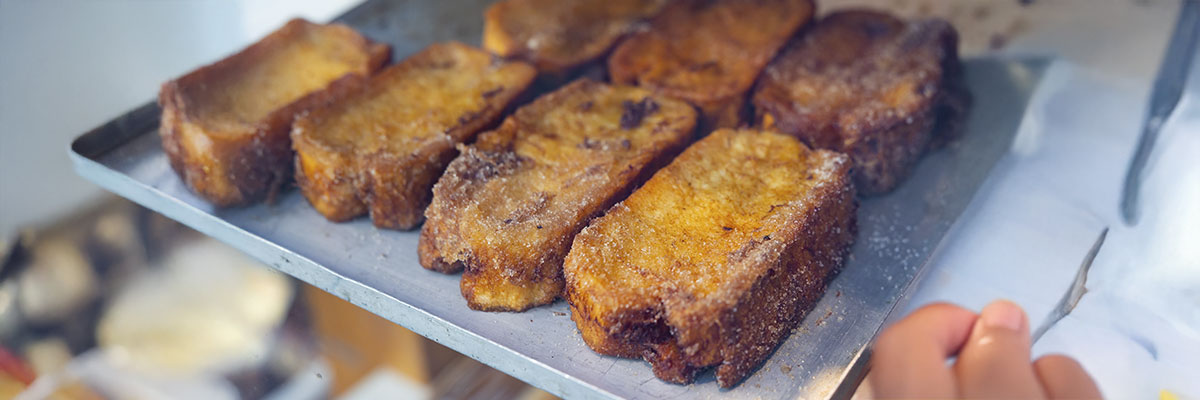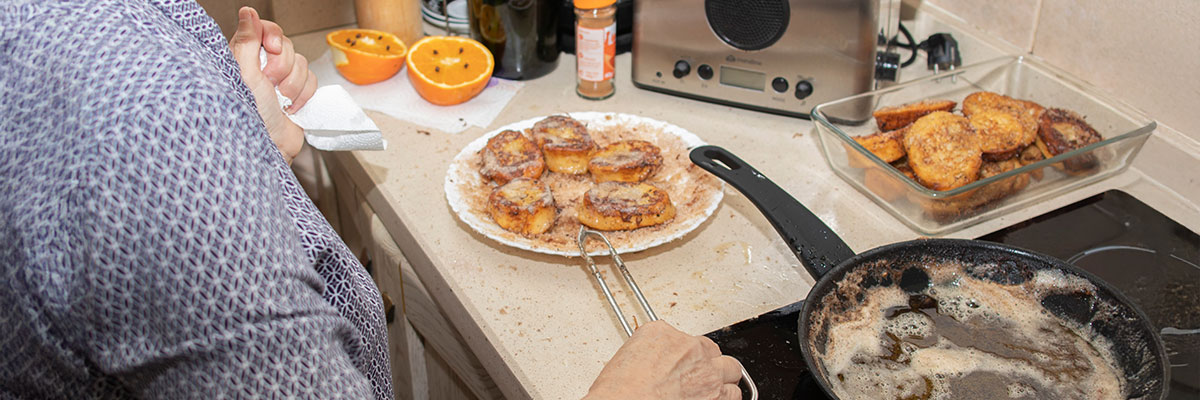
Easter is approaching and one of the most popular desserts in Spain at this time of year is torrijas. Have you ever tried them? There are many versions of this dessert, but only one original recipe to make them and make them delicious.
In this article from Enforex you will learn everything you need to know about torrijas, their origin, the original recipe, how to make it and adapt them to your type of diet, and much more. Don't miss anything!
The origin of torrijas
Torrijas are one of the most typical and beloved desserts of Spanish cuisine, especially during Easter week. This simple bread-based dessert has a long history that mixes religious tradition, food preservation and popular culture.
Although many people associate torrijas exclusively with Easter, the truth is that their origin is much older. The first references to a similar sweet date back to the Roman Empire. The gourmet Apicius, in the first century AD, already described a recipe for bread soaked in milk and then fried, a sweet very similar to today's torrijas.
However, the first written reference in Spanish appears in the 15th century, in a medieval cookbook. Later, in the 17th century, the poet and playwright Lope de Vega mentions torrijas in his work, and it was at that moment that their popularity began to grow.
Curiously, for centuries they were also served as food for women who had just given birth, as they were an energy-giving, nutritious and easy to digest dish.
Why do we eat French toast at Easter?
Torrijas has become associated with Easter for several reasons:
- Making use of stale bread. During Lent, many families avoided wasting food, so torrijas are an ideal recipe for reusing the day-old bread.
- Meatless recipe. During the days of fasting, especially Good Friday, Christians would fast or avoid eating meat. Thus, torrija, rich and filling, was a way to satisfy the appetite without breaking this tradition.
- Religious symbol. Many see in torrijas a metaphor for the body of Christ. Bread is a recurring symbol in the Christian liturgy and the act of soaking, frying and sweetening it can be understood as a gesture of spiritual preparation.

In this way, what began as a simple dessert ended up becoming a gastronomic symbol of Easter throughout Spain.
Original recipe for torrijas
But the most interesting thing about torrijas is their flavor, so to prepare the original recipe for torrijas you need these ingredients:
- 1 loaf of bread from the day before (preferably special bread for torrijas)
- 1 liter of whole milk
- 1 cinnamon stick
- The zest of 1 lemon (optionally, also of orange)
- 3-4 tablespoons of sugar
- 2 eggs
- Mild olive oil for frying
- Sugar and ground cinnamon for sprinkling
Preparation:
Steep up the hot milk with lemon peel and the cinnamon stick. Then add the sugar and allow it to dissolve. When it starts to boil, remove it from the heat and leave it cool.
Next, cut the bread into slices about 2 cm thick and pour the warm milk into a bowl and then soak the slices of bread in it. Let the bread absorb it well, but without letting it melt.

The next step is to carefully dip each slice in beaten egg. And finally, fry the French toast in plenty of hot oil until golden brown on both sides. Once golden brown, place them on paper towels to remove excess oil.
The special touch comes now, mix sugar with ground cinnamon and sprinkle on the still hot French toast or dip them in the sugar and cinnamon mixture, as you like.
Optionally, you can bathe them in honey dissolved in hot water for a more traditional southern Spanish version.

If you are vegan or lactose or egg intolerant, here are the perfect ingredients for an equally delicious recipe for French toast.
Ingredients: 1 loaf of day-old bread, 1 liter of plant-based drink, 2-3 tablespoons of sugar or agave syrup, 1 cinnamon stick, zest of 1 lemon, 1 tablespoon of corn flour or chickpea flour, 1 cup of additional vegetable drink to dilute the corn flour, vegetable oil for frying and, optionally, sugar and ground cinnamon for sprinkling.
The preparation is just as simple as the previous one: in a saucepan, heat the vegetable drink with cinnamon, lemon peel and sugar. When it comes to boiling, remove from the heat and leave it to cool. Cut the bread into thick slices, place on a tray and pour over the warm vegetable milk until the bread absorbs it well. Now mix the corn flour with the cup of vegetable drink until you get a slightly thick mixture. Dip each slice of bread in the corn flour mixture and fry in hot oil until golden brown. Then place them on absorbent paper and sprinkle with sugar and cinnamon.
Interesting facts about French toast
Similar versions exist in other countries: “pain perdu” in France, “French toast” in the USA and “Arme Ritter” in Germany.
Furthermore, in some areas of Spain, such as Castile and León or Andalusia, they are flavored with wine instead of milk.
Although traditionally they are eaten cold or at room temperature, many people also enjoy them hot.
Torrijas are not only a delicious dessert, but also a piece of history and culture that is passed down from generation to generation. A simple, humble recipe full of meaning.
-
 Calçots: what they are, origin and recipe Calçots: discover the origin and tradition behind calçots in Spain. Did you know all these facts about calçots?
Calçots: what they are, origin and recipe Calçots: discover the origin and tradition behind calçots in Spain. Did you know all these facts about calçots? -
 Traditional Spanish food Traditional Spanish food: discover here the 12 most popular traditional Spanish dishes of the Spanish gastronomy. Did you know all of them?
Traditional Spanish food Traditional Spanish food: discover here the 12 most popular traditional Spanish dishes of the Spanish gastronomy. Did you know all of them? -
 The most typical Christmas desserts in Spain The most typical Christmas desserts in Spain are here to you. In this article you can find the 10 most popular Spanish Christmas desserts.
The most typical Christmas desserts in Spain The most typical Christmas desserts in Spain are here to you. In this article you can find the 10 most popular Spanish Christmas desserts.


